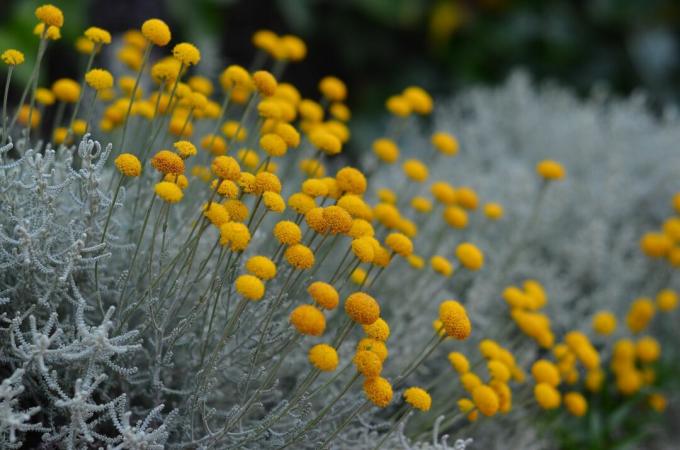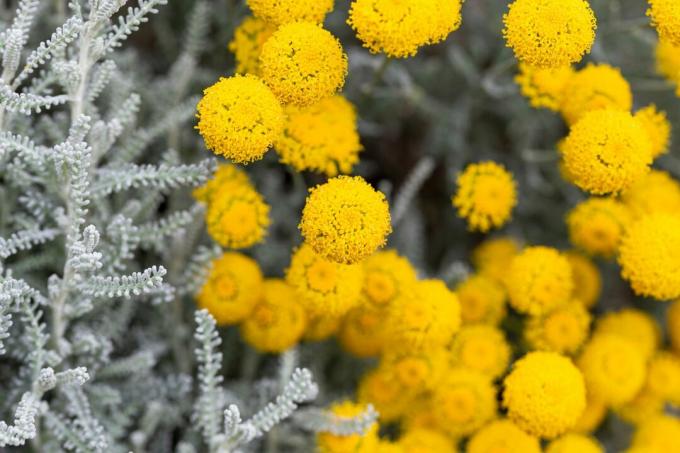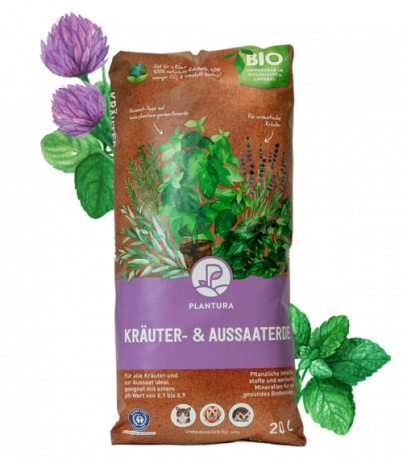The holy herb convinces with its scent and at the same time deters vermin. Lovers of the rock garden will be delighted with the Mediterranean herb, because a barren and dry subsoil suits it particularly well.

The Holy Herb (Santolina) is considered an easy-care all-rounder, while its evergreen leaves provide a beautiful accent all year round. With its yellow flower heads, the holy herb is not only a feast for the eyes and bees, but also inspires the sense of smell and taste with its aromatic scent. We'll show you how to do the Mediterranean Santolina plants correctly and how to propagate by cuttings.
Contents
- Holy herb: origin and properties
- The most beautiful species
- Plants: location, soil and Co.
- Care of Holy Herb
- Is holy herb hardy?
- multiply holy herb
- Effect and use of holy herb
Holy herb: origin and properties
The name Heiligenkraut includes the genus of plants Santolina from the daisy family (Asteraceae). The genus includes 24 species that are native to the western Mediterranean and are widely distributed. If a location with similar Mediterranean conditions is required, three types of holy herb also feel at home in our gardens.
santolinaSpecies can differ in their growth form and height as well as leaf color and structure. Depending on the species, the plant grows predominantly branched and upright, prostrate or overhanging and can reach a height of between 10 and 70 cm.

Holy herb leaves usually have a narrow and finely pinnate leaf blade, with their color varying between silvery-grey and sap green depending on the species. Stems and leaf surfaces are often felted grey, which protects the plant from evaporation and sun damage.
Characteristic of the holy herb is its blossom. In the period from July to August, all species sprout many small, spherical cups that are white-yellow to golden-yellow in color. The flower can then give rise to fruits in the form of achenes. In addition, the tart, aromatic scent of the blossom and leaves is a trademark of all sacred herbs.

The most beautiful species
In our gardens are predominantly three santolinaSpecies cultivated as useful and ornamental plants:
- gray saintweed (Santolina chamaecyparissus): The gray holy herb, also called cypress herb or silver-leaved holy herb, is a 15 - 50 cm high, evergreen dwarf shrub with a clumpy growth habit. Its leaves are needle-like in shape, slightly pinnate and gray felted. It sprout yellow cup-shaped flowers between July and August. Leaves and flowers spread a sweet aromatic scent.

- Rosemary-leaved Holy Herb (Santolina rosmarinifolia ssp. canescens): Rosemary-leaved holy herb, also known as grey-green holy herb or rosemary heather, is a 30 - 50 cm high, evergreen subshrub with an upright, clumpy growth habit. Its foliage is grey-green in colour, narrow and needle-shaped. Yellow flower heads appear between July and August. Leaves and flowers smell slightly sweet.

- olive herb (Santolina viridis): The olive herb, also called green holy herb, is a 25 - 60 cm high, evergreen subshrub with a branched, bushy growth habit. Its leaves are needle-like, pinnate, light to dark green in color and have terminal buds. Small, light yellow flower heads bloom between May and June. The aromatic, olive-like scent of its leaves and flowers gives the herb its name.

Plants: location, soil and Co.
Suitable as a Mediterranean plant Santolina ideal for greening rock gardens and roofs. It thrives particularly well on poor, well-drained soil with a sandy or stony subsoil. The undemanding holy herb prefers a nutrient-poor soil with an increased pH value.
The location of the sanctuary should be as warm, dry and sunny as possible. Moist, humus-rich and shady locations must be avoided, otherwise the herb will wither. In order to avoid root rot, a dry location should also be ensured by sufficient drainage. Alternatively, the garden soil can be thinned with grit or sand.
The holy herb is planted at intervals of about 30 cm in small excavations that roughly correspond to 1.5 times its root system. Subsequent watering and a light blanket of gravel ensure that the seedling develops well. The holy herb can be planted at any time of the year, but best in spring and only on frost-free days.

Tip: Since the holy herb tolerates pruning, it is ideal for edging beds.
You are welcome to place the yellow flowers with neighbors with similar preferences. So the holy herb can be used together with other Mediterranean plants such as lavender(Lavandula spec.), rosemary (Rosmarinus officinalis) or sage(Salvia officinalis) form a colour-coordinated carpet of flowers. As a welcome side effect Santolinas Scent even pests away from its neighbors.
As a container plant should Santolina planted in a pot at least 25 cm in diameter. However, the holy herb only thrives in a suitable substrate. Here you should use a peat-free, little water-storing soil. For example, we recommend our peat-free Plantura Organic Herb & Seed Soil. It is optimally low in nutrients and promotes Santolina especially in their aroma and root development. In addition, you should thin our earth with a 50% sand or gravel content, so that Santolina does not get too many nutrients or even wet roots.

Organic Herb & Sowing Soil 20 L
- Ideal for herbs as well as for sowing, propagating cuttings and pricking out
- Ensures aromatic herbs & strong young plants with strong roots
- Peat-free & climate-friendly: CO2-reduced organic soil made in Germany
Care of Holy Herb
The frugal holy herb requires little care. Moderate fertilization is sufficient to promote aroma development Santolina completely off. In nutrient-rich locations, the herb requires almost no attention in the form of fertilizers. If there is no new growth despite pruning, ours, for example, is suitable Plantura organic universal fertilizer. This organic fertilizer promotes with its balanced NPK ratio Santolinas Root growth, which in the long term can contribute to the herb developing its full aroma. All in all, the holy herb thrives best with only a few nutrients, which is why you should only use half the recommended amount of our fertilizer.
In principle, you also have to water your holy herb little, even in dry summer periods. This prevents root rot and promotes an aromatic harvest - because drought is a driver for rich aromatic substance synthesis.
Regular pruning is recommended to prevent the saint's herb from growing too sprawling and "falling apart". So will Santolinas compact branching and the plant always stays nice and bushy. Here you should cut the holy herb in the spring. This must be done before the growing season, ideally before the end of May. But beware! A cut in already old, thick and woody stems should be avoided - otherwise the subshrub may not sprout again. If the holy herb does not bloom, the available amount of water or the light supply may not be right. If in doubt, you can first vary the watering and wait to see whether the flower will appear again the following year. Otherwise would have to Santolina be moved to a sunnier and drier spot.

Is holy herb hardy?
Santolina is sufficiently hardy if it is in a sheltered position. In the most exposed places, the substrate and the plant should be covered with brushwood in winter. Adequate drainage in the ground or pot or a roof protects against winter wetness.
Since potted plants are more at risk of frost, they should be brought into the apartment or shed. You should make sure that Santolina winters in a bright and cool environment and that a temperature of 10 °C is not exceeded - the plant must not get too warm in winter. Alternatively, it helps outside to wrap a jute sack around the pot and then place it on wood.
multiply holy herb
It is easy to propagate holy herb - with cuttings from spring to summer:
- Between spring and summer approx. Cut off 15 - 20 cm of a woodless shoot and remove lower leaves.
- Put in a pot with coarse, sandy, nutrient-poor soil, water and cover with transparent foil.
- Place cuttings in a warm and bright place in winter, at temperatures of approx. 21 - 25 ° C.
- Always keep the substrate moist and protect the roots or Wait for drive formation.
- Plant in a sunny, barren and dry location from mid-May.
Sowing in spring or autumn is also possible with your own holy herb seeds:
- Lightly press seeds into pots with sandy or rocky substrate and little potting soil.
- For germination, place the pot in a bright place, moisten the seeds regularly and keep them at approx. Store at 20°C.
- Plant in a sunny, barren and dry place in the coming spring.

Effect and use of holy herb
Since the 17th In the 19th century sacred herbs with their blossom and fragrance are a welcome ornament for beds. Holy herb is also used as a useful and medicinal plant. Its essential oils, tannins and bitter substances drive away unwanted insects. With it works Santolina repels mosquitoes and moths in the closet.
Although unpopular with pests, sacred herbs are not poisonous. They can be touched and even eaten by adults and children, dogs and cats without hesitation. Due to its spicy aroma, the edible holy herb is used in delicious recipes. Santolinas fresh shoot tips give spreads and salads a tasty touch. For example, you can conjure up a spicy pesto from the olive herb.
In addition, the holy herb is said to have a healing effect. Its essential oils, such as myrcene or cineol, are said to have anti-inflammatory and antimicrobial effects. Leaves, flowers and seeds of the sacred herb are therefore often infused into tea, which is said to relieve gastrointestinal infections or flatulence, among other things.

Holy herb is ideal for the local rock garden and can also develop best there. How you such a Create a rock garden you can find out here.
Register now for our Plantura garden post, secure a 10% welcome discount for our online shop and Weekly great tips, seasonal trends and inspiration for all things gardening from our expert receive.



